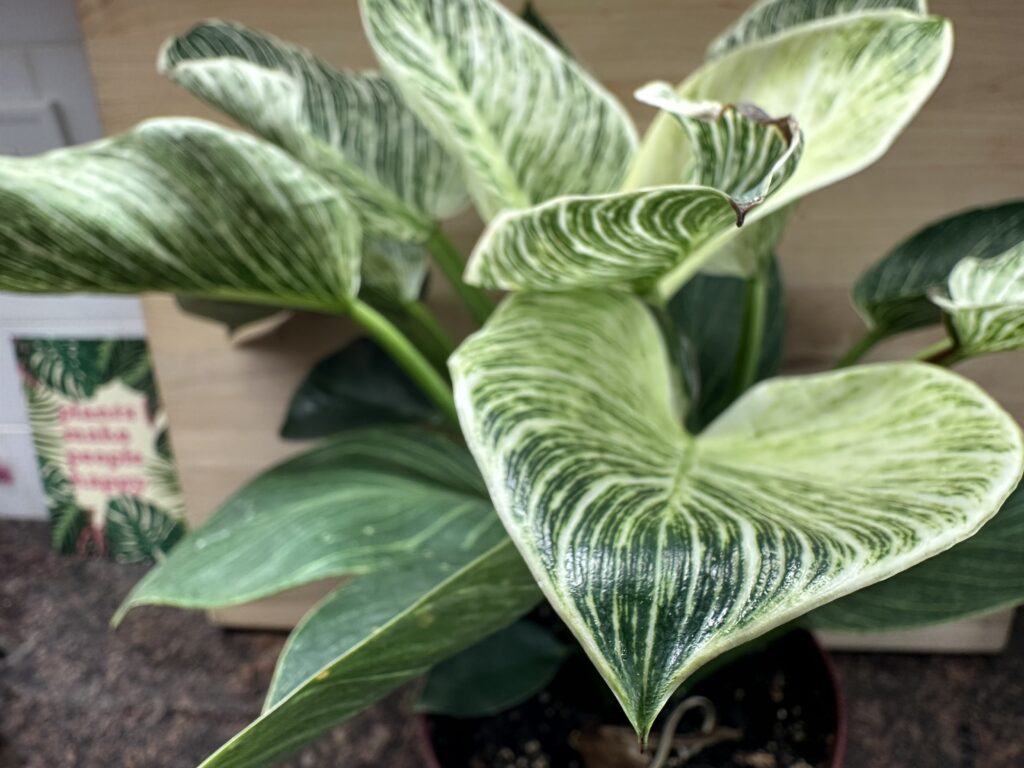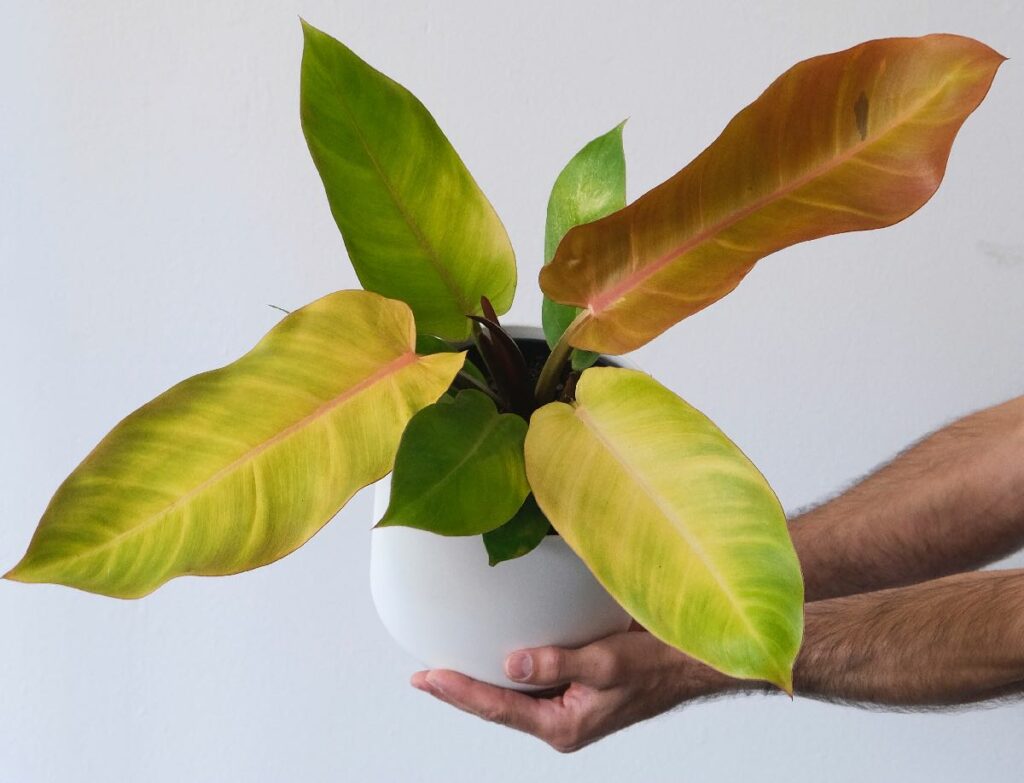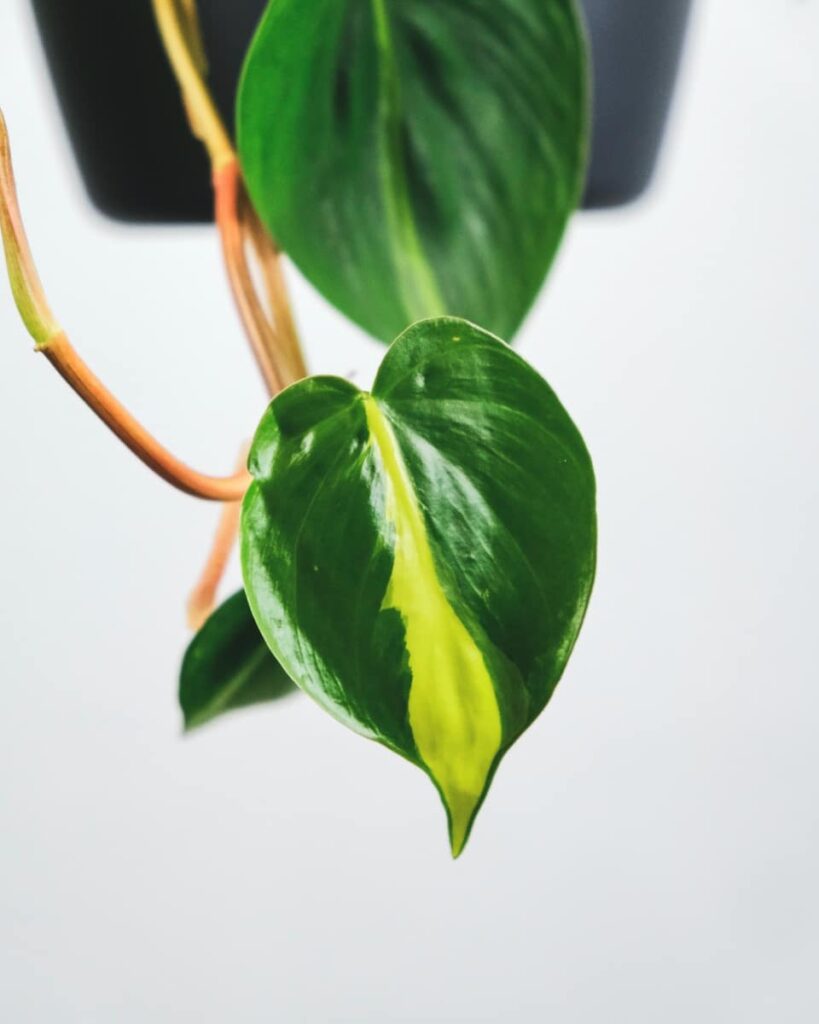Variegated philodendrons are a plant enthusiast’s dream come true, thanks to their striking and unique foliage. These plants boast leaves that are variegated, meaning they feature a combination of different colors and patterns. The result is a visually stunning plant that can add a touch of elegance to any indoor or outdoor space.
What’s more, variegated philodendrons come in a range of shapes and sizes, making them a versatile addition to any plant collection. But what makes these plants even more appealing is their ease of care. They can thrive in a variety of lighting conditions, from bright indirect light to low light, and can tolerate a range of temperatures. Plus, they are relatively low-maintenance and can be propagated with ease, making them an excellent choice for novice plant owners.
In this comprehensive guide to variegated philodendrons, we’ll dive into the different types of variegated philodendrons, their care requirements, and tips for keeping them healthy and thriving. Whether you’re a seasoned plant enthusiast or a beginner looking to add some greenery to your space, this guide will equip you with all the information you need to successfully grow and care for variegated philodendrons.
Types of Variegated Philodendrons
Philodendrons are a popular choice for houseplants due to their ease of care and stunning foliage. Among the most sought-after varieties are the variegated philodendrons, which boast unique and eye-catching patterns. Here are some of the most popular types of variegated philodendrons:
Philodendron Birkin

This variety features dark green leaves with striking white stripes that resemble brushstrokes. The variegation is most prominent on the newer leaves and can fade as the plant matures. For fans of these stunning leaves, the Philodendron Birkin may be the perfect plant choice.
Philodendron Brasil

The Philodendron Brasil is a classic variegated philodendron with bright green leaves and yellow stripes. It is a fast-growing plant that can quickly fill up a space with its lush foliage.
Philodendron Lemon Lime

As the name suggests, the Lemon Lime Philodendron has bright green and yellow variegation that resembles a lemon-lime color scheme. It is a compact plant that is perfect for smaller spaces.
Philodendron Prince of Orange

This variety has unique orange and green variegation that becomes more pronounced as the plant matures. It is a slow-growing plant that can be a bit finicky, but its stunning foliage is worth the effort. The Philodendron Prince of Orange is a great and stunning choice for a new tropical plant.
Philodendron Pink Princess

The Pink Princess Philodendron is a highly sought after philodendron with dark green leaves and pink variegation. It is a slow-growing plant that requires bright, indirect light to maintain its vibrant colors.
As you can see, there are many types of variegated philodendrons available, each with its own unique pattern and growth habits. It’s important to research and choose the one that best fits your space and care abilities.
Growing Conditions for Variegated Philodendrons
Variegated philodendrons are a highly sought-after indoor plant due to their unique and striking foliage. However, to ensure that your variegated philodendron thrives, it is crucial to provide it with the right growing conditions. Here are some tips on how to create the ideal environment for your variegated philodendron:
Light is a crucial factor in the growth of variegated philodendrons. These plants require bright, indirect light to thrive. Direct sunlight can scorch their leaves, while too little light can cause the variegation to fade. Therefore, it is essential to place your plant near a window that receives bright, filtered light, or use artificial grow lights if natural light is limited.
Temperature is another critical factor in the growth of variegated philodendrons. These plants prefer warm temperatures between 65-80°F (18-27°C). It is important to avoid exposing your plant to cold drafts or temperatures below 55°F (13°C), as this can cause damage to the leaves.
Humidity is also a crucial factor in the growth of variegated philodendrons. These plants thrive in high humidity environments, so it is important to keep the air around them moist. You can achieve this by misting the leaves regularly, placing a humidifier nearby, or grouping your plants together to create a microclimate.
Soil is another critical factor in the growth of variegated philodendrons. These plants prefer well-draining soil that is rich in organic matter. A mix of peat moss, perlite, and vermiculite is ideal. It is essential to avoid using heavy soils that retain too much moisture, as this can lead to root rot.
Watering is another crucial factor in the growth of variegated philodendrons. It is essential to water your variegated philodendron when the top inch of soil feels dry to the touch. Overwatering can cause the roots to rot, so it is better to underwater than overwater. These plants are more tolerant of drought than excess moisture.
Fertilizer is also a crucial factor in the growth of variegated philodendrons. These plants benefit from regular fertilization during the growing season (spring and summer). It is essential to use a balanced, water-soluble fertilizer every 2-3 weeks to promote healthy growth and vibrant foliage.
By providing your variegated philodendron with the right growing conditions, you can enjoy its stunning foliage for years to come. With a little care and attention, these plants can thrive in any indoor environment.
Watering and Fertilizing Variegated Philodendrons

Variegated Philodendrons are a sight to behold, but they require some serious TLC to keep them healthy and happy. Here are some tips to help you master the art of watering and fertilizing your variegated Philodendrons.
Watering
Keeping your variegated Philodendrons hydrated is crucial, but don’t go overboard. Overwatering can lead to root rot, which is a death sentence for your plant. To avoid this, make sure the soil is moist but not waterlogged. Let the soil dry out a bit between waterings, and only water when the top inch of soil is dry to the touch.
When it’s time to water, give your plant a thorough soak and let the excess water drain out of the pot. Don’t forget to empty the saucer underneath the pot to prevent your plant from sitting in standing water. In the winter months, you can cut back on watering, but keep an eye on the soil moisture level and adjust accordingly.
Fertilizing
Your variegated Philodendrons need nutrients to grow and thrive, so fertilizing is a must. During the growing season, apply a balanced, water-soluble fertilizer every two weeks. But be careful not to overdo it – too much fertilizer can burn the roots and damage your plant.
In the winter months, you can reduce or stop fertilizing altogether since your plant isn’t actively growing. Just remember to resume fertilizing when the growing season starts up again.
Watering and fertilizing your variegated Philodendrons is essential for their health and longevity. By following these tips, you’ll be well on your way to having a thriving, beautiful plant.
Propagating Variegated Philodendrons
Propagating variegated philodendrons is a fascinating and intricate process that requires a great deal of skill and patience. There are several methods that you can use to propagate these stunning plants, including stem cuttings, division, and air layering.
Stem Cuttings
Stem cuttings are the most common method of propagating variegated philodendrons. To do this, you will need a healthy stem with at least two nodes. Cut the stem just below a node, and remove any leaves from the bottom node. Dip the cut end in rooting hormone, and plant it in a pot filled with well-draining soil. Keep the soil moist and place the pot in a bright, indirect light. In a few weeks, you should see new growth emerging from the top of the cutting.
Division
Division is another method of propagating variegated philodendrons. This method is best for plants that have outgrown their pots or have multiple stems. To divide a plant, gently remove it from its pot and separate the stems and roots. Each stem should have its own root system. Plant each stem in a pot filled with well-draining soil, and water thoroughly. Keep the pots in a bright, indirect light and water as needed.
Air Layering
Air layering is a more advanced method of propagating variegated philodendrons. This method involves creating a small wound on the stem and encouraging roots to grow from the wound. To do this, select a healthy stem and make a small cut just below a node. Wrap the cut area with damp sphagnum moss, and cover it with plastic wrap. Secure the plastic wrap with tape, and wait for roots to grow from the wound. Once roots have formed, cut the stem below the wound and plant it in a pot filled with well-draining soil.
Propagating variegated philodendrons is a complex and intricate process that requires a great deal of skill and patience. Whether you choose to use stem cuttings, division, or air layering, these methods are all effective ways to propagate these beautiful plants. With a little patience and care, you can enjoy a thriving collection of variegated philodendrons in no time.
Common Pests and Diseases of Variegated Philodendrons

Variegated Philodendrons are a sight to behold, with their unique and stunning appearance that can elevate any indoor or outdoor space. However, as with any other plant, they are not immune to the dangers of pests and diseases that can wreak havoc on their health and beauty. Here are some of the most common pests and diseases that can afflict Variegated Philodendrons:
Spider Mites
These pesky little creatures are a common sight in indoor plants and can cause significant damage by sucking the sap from the leaves. You can easily identify spider mites by the fine webbing they leave on the plant. To get rid of these pests, you can use insecticidal soap or neem oil, which are effective in controlling their population.
Mealybugs
These cotton-like insects are another common pest that can be found on the leaves and stems of Variegated Philodendrons. They can cause damage by sucking the sap from the plant and can also spread diseases. To get rid of mealybugs, you can use insecticidal soap or neem oil, which can effectively control their population.
Scale Insects
These oval-shaped insects are yet another pest that can cause significant damage to Variegated Philodendrons by sucking the sap from the plant. They can also spread diseases, making them a double threat. To get rid of scale insects, you can use insecticidal soap or neem oil, which can effectively control their population.
Root Rot
Root rot is a common disease that can affect Variegated Philodendrons, caused by overwatering or poor drainage. This can lead to the roots becoming waterlogged and rotting, which can be fatal to the plant. To prevent root rot, make sure to water your plant only when the soil is dry to the touch and ensure that the pot has proper drainage.
Leaf Spot
Leaf spot is a fungal disease that can affect Variegated Philodendrons, characterized by brown or black spots on the leaves. This can eventually cause the leaves to fall off, which can be detrimental to the plant’s health. To prevent leaf spot, make sure to water your plant only when the soil is dry to the touch and avoid getting water on the leaves.
Variegated Philodendrons are stunning plants that require proper care and attention to thrive. By being aware of the common pests and diseases that can affect them, you can take the necessary steps to prevent and treat any issues that may arise. With the right care, your Variegated Philodendron can be a breathtaking addition to your home or garden for years to come.
Troubleshooting Variegated Philodendrons

Variegated Philodendrons are a sight to behold, with their unique and stunning appearance that can add a touch of elegance to any indoor space. Fear not, for we have compiled a list of common problems that you may encounter while growing Variegated Philodendrons and how to troubleshoot them. Make sure that you are not watering the plant too frequently and that the soil is well-draining.
Also, check if the plant is getting enough sunlight. If the leaves are turning yellow from the bottom up, it could be a sign of natural aging, and you can simply prune the affected leaves, leaving you feeling relieved. Remove the affected leaves and make sure to keep the plant in a well-ventilated area. Avoid overwatering and make sure that the soil is not too wet. You can also use a fungicide to treat the plant, leaving you feeling confident in your ability to care for your plant.
Make sure that you are watering the plant regularly and that the soil is not too dry. Also, check if the plant is getting enough sunlight. If the leaves are wilting from the bottom up, it could be a sign of natural aging, and you can simply prune the affected leaves, leaving you feeling relieved. Check the plant regularly for any signs of infestation, such as webbing, sticky residue, or tiny insects. You can use insecticidal soap or neem oil to treat the plant, leaving you feeling confident in your ability to care for your plant. By troubleshooting any issues that may arise, you can ensure that your plant stays healthy and vibrant. Remember to always check the plant regularly and provide it with the right amount of water, sunlight, and nutrients, leaving you feeling confident in your ability to care for your plant.
Decorating with Variegated Philodendrons
Variegated philodendrons are a fantastic addition to any home decor. Their unique patterns and colors make them stand out from other houseplants, adding a touch of greenery and color to any room. Here are some tips on how to decorate with variegated philodendrons that will leave your guests in awe:
Use them as a focal point
These eye-catching plants are perfect for drawing attention to a specific area of your room. Place them on a pedestal or a plant stand to create a stunning focal point.
Mix and match
With different patterns and colors, variegated philodendrons are perfect for creating a unique display. Mix them with other houseplants to create a lush and vibrant display that will leave your guests in awe.
Use them in different rooms
These versatile plants can be used in any room of your home. From living rooms to bedrooms, bathrooms, and even kitchens, variegated philodendrons will add a touch of elegance to any space.
Use them in different containers
Variegated philodendrons look great in different containers, such as ceramic pots, hanging baskets, and terrariums. Choose a container that complements the plant’s pattern and color to create a stunning display.
Use them as a backdrop
These plants can also be used as a backdrop for other decor items. Place them behind a piece of art or a decorative object to create a beautiful display that will leave your guests in awe.
Variegated philodendrons are versatile and beautiful houseplants that can enhance any home decor. Use them as a focal point, mix and match them, use them in different rooms and containers, and use them as a backdrop to create a stunning display that will leave your guests in awe.
Conclusion and Additional Resources for Variegated Philodendrons
Variegated philodendrons are a fascinating and captivating addition to any indoor garden. Their unique patterns and colors can add a pop of interest and reduce stress in any space, but caring for these plants can be a bit more challenging than caring for their non-variegated counterparts. It’s crucial to provide them with the right amount of light, water, and nutrients to keep them healthy and thriving.
To ensure that your variegated philodendrons stay healthy and beautiful for years to come, follow the tips and tricks outlined in this ultimate guide. Keep an eye out for any signs of stress or disease, and don’t be afraid to adjust your care routine as needed. Remember, these plants require a bit more attention and care than other houseplants, but the payoff is well worth it.
Frequently Asked Questions
What are variegated philodendrons?
Variegated philodendrons are a type of philodendron plant that have leaves with different colors and patterns. These patterns can include stripes, spots, and patches of different shades of green, white, yellow, or pink.
How do I care for variegated philodendrons?
Variegated philodendrons require similar care to other philodendron plants. They prefer bright, indirect light and well-draining soil. Water them when the top inch of soil is dry, and avoid overwatering. Fertilize them every 2-3 months during the growing season. They also benefit from occasional misting and pruning to encourage bushier growth.
Can variegated philodendrons be propagated?
Yes, variegated philodendrons can be propagated through stem cuttings. Take a cutting with at least one node and place it in water or moist soil until roots develop. Once the roots have formed, transplant the cutting into a pot with well-draining soil and care for it as you would a mature plant.
What are some popular variegated philodendron varieties?
Some popular variegated philodendron varieties include Philodendron Birkin, Philodendron Brasil, Philodendron Lemon Lime, Philodendron Prince of Orange, and Philodendron Pink Princess. Each variety has its own unique color and pattern of variegation.
Can variegated philodendrons be grown outdoors?
Variegated philodendrons can be grown outdoors in warm, humid climates with partial shade. They prefer temperatures between 65-85°F and high humidity. However, they are also sensitive to cold temperatures and frost, so they should be brought indoors or protected during the winter months in colder climates.

